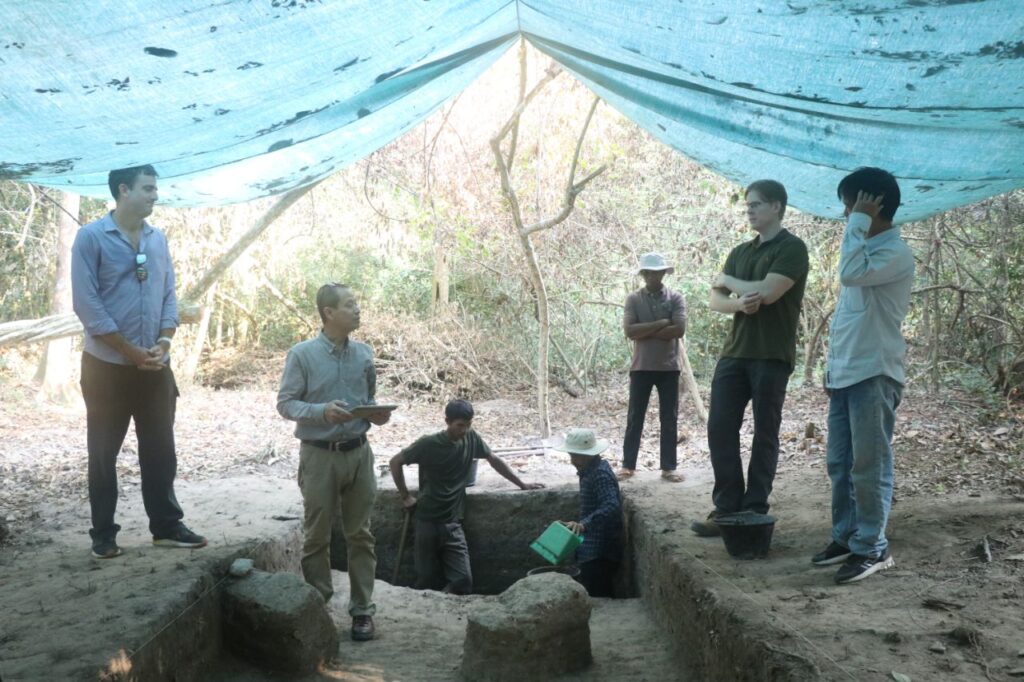គម្រោងស្រាវជ្រាវព្រះវិហារសម័យអង្គររបស់សាកលវិទ្យាល័យតូរិនតូប្រទេសកាណាដា ក្រោមកិច្ចសហការជាមួយអាជ្ញាធរជាតិអប្សរា កំពុងធ្វើកំណាយស្រាវជ្រាវ នៅខឿន ព្រះវិហារបុរាណមួយ ស្ថិតនៅខាងកើតប្រាសាទបាយ័ន ចម្ងាយប្រមាណ២០០ម៉ែត្រ។ ការស្រាវជ្រាវបង្កើតទ្បើងក្នុងគោលបំណងស្វែងយល់អំពីតួនាទីរបស់រចនាសម្ពន្ធ និងតួនាទីរបស់សំណងបុរាណនានាដែលក្នុងនោះរួមមាន ខឿនព្រះវិហារ ខឿនកាកបាទ ស្ថិតខាងលិចជាប់នឹងព្រះវិហារ និងសំណង់ខឿនព្រះធាតុ។ ជាពិសេសគឺ ស្វែងយល់ អំពីសម័យកាលវិវត្តន៍នៃការគោរពបូជាព្រះពុទ្ធសាសនានាចុងសម័យអង្គរ។
លោក Andrew Harris ជាប្រធានគម្រោងស្រាវជ្រាវព្រះវិហារសម័យអង្គរ (Angkor Vihara Project) បានឱ្យដឹងថា នេះជាគម្រោងកំណាយស្រាវជ្រាវលើកទី៣ លើខឿនព្រះវិហារ នៅក្នុងក្រុងអង្គរធំ។ លោកពន្យល់ថា កំណាយស្រាវជ្រាវនេះធ្វើឡើងក្នុងបំណង ស្វែងយល់ពីតួនាទីខឿនកាកបាទ និងខឿនព្រះពុទ្ធសាសនាដែលស្ថិតនៅជ្រុងខាងកើត ដើម្បីដឹងពីអាយុកាល និងតួនាទីនៃសំណង់ទាំងនោះ។ លោកបញ្ជាក់បន្ថែមថា ការងារលើកនេះ គឺរួមបញ្ចូលទាំងការសិក្សាអំពីតួនាទី មុខងារ អាយុកាលរបស់ខឿនព្រះធាតុ ដែលស្ថិតនៅដាច់ អំពីសំណង់ព្រះវិហារបុរាណ និងជាពិសេសគឺស្វែងយល់អំពីទំនាក់ទំនង ប្រើប្រាស់ របស់សំណង់ ព្រះវិហារទៅជាមួយនឹងសហគមន៍មនុស្សរស់នៅជុំវិញ។ល។
កំណាយស្រាវជ្រាវក្នុងរយៈពេលជិតមួយខែកន្លងមក ដល់ថ្ងៃទី៧ ខែ កុម្ភៈ ឆ្នាំ២០២៣ លោក Andrew Harris បានពន្យល់នូវរបកគំហើញនានា ដូចជាមានការរកឃើញ គំនរបំណែកក្បឿន នៅលើខឿនកាកបាទ ដែលជាសក្ខីភាពបញ្ជាក់អំពីសំណង់ឈើប្រក់ក្បឿង មានវត្តមាន នៅលើខឿននេះ។ ជាទូទៅក្រៅអំពីបំណែកកុលាលភាជន៍ខ្មែរ និងភាជន៍ចិន ដែលជាភស្តុតាង ការ ប្រើប្រាស់ នាសម័យអង្គរ ក្រុមការងារក៏ជួបប្រទះ នូវភស្តុតាងនៃការប្រើប្រាស់កុលាលភាជន៍ សម័យក្រោយអង្គរ (នាសតវត្សរ៍ទី១៦ទៅ១៧) នៅក្នុងស្រទាប់ជិតព្រះវិហារ។ ជាពិសេស ចាស់បុរាណនាសម័យក្រោយអង្គរលោកបានបញ្ចុះធាតុអ្នកស្លាប់ក្នុងកូនក្រឡកប់ក្នុងដីបរិវេណខឿនកាកបាទ ទៅតាមទំនៀមទម្លាប់ជំនឿព្រះពុទ្ធសាសនា។ ជាងនេះទៅទៀត គេក៏ប្រទះឃើញស្លាកស្នាមទឹកហូរ ចេញចូលពីស្រះទឹកដ៏ធំមួយក្បែរនោះ ទៅមុខព្រះវិហារ ផងដែរ។
កិច្ចការសហការសិក្សាស្រាវជ្រាវសំណង់ខឿនព្រះវិហារសម័យអង្គរនេះបង្ហាញនូវភស្តុតាងមួយចំនួនទាក់ទងនឹងការវិវត្តសង្គមសាសននាចុងសម័យអង្គរ និងសង្គមមនុស្ស បន្តរស់នៅ ក្រោយ ការរផ្លាស់ប្ដូររាជធានីទៅភាគខាងត្បូង។ លោក Andrew Harris ពន្យល់បន្ថែមថា កន្លងមក អ្នកស្រាវជ្រាវយល់ថារាជធានីអង្គរត្រូវបានគេបោះបង់ចោល និងពុំមានមនុស្សរស់នៅ។ តែតាមរយៈការសិក្សាថ្មីៗរបស់អ្នកស្រាវជ្រាវជាតិ និងអន្តរជាតិ រួមទាំងការស្រាវជ្រាវ ទាំងបី លើកក្នុងគម្រោងព្រះវិហារអង្គរ ក៏បានបន្ថែមនូវភស្តុតាងសំខាន់ៗមួយចំនួន ដែលអាចបញ្ជាក់អំពីការផ្លាស់ប្តូរជំនឿសាសនា និងការស្ថាបនាសំណង់សាសនា តាមបែប ទស្សនៈព្រះពុទ្ធសាសនា ដែលអាចរាប់ចាប់ពីចុងសតវត្សរ៍ទី១៣ ដល់ទីបញ្ចប់ សតវត្សរ៍ទី១៤ និងជាពិសេសនៅសតវត្សរ៍ទី១៦ តរៀងមក។
តាមរយៈសិល្បៈសំណង់ព្រះវិហារនីមួយៗក្នុងក្រុងអង្គរធំ បញ្ជាក់នូវ អាយុកាល នៃការស្ថាបនា នាចុងសម័យអង្គរ និងមានសំណង់មួយចំនួនតូចទាក់ទងនឹងសម័យក្រោយអង្គរ។ ជាការពិត ណាស់ ព្រះវិហារមួយចំនួនត្រូវបានកែលម្អ ឬស្ថាបនាក្រោយវត្តមានព្រះបាទអង្គចន្ទ ព្រះរាជវង្ស និងព្រះពុទ្ធសាសនឹងត្រលប់មកកាន់រាធានីចាស់។
របកគំហើញថ្មីៗរបស់ក្រុមស្រាវជ្រាវជាតិ និងអន្តរជាតិ ផ្តល់លទ្ធភាពក្នុងការចងក្រងប្រវត្តិសាស្រ្ត មួយបែបថ្មី ដែលកន្លងមកតែងយល់ថាព្រះវិហារក្នុងរាធានីអង្គរត្រូវបានស្ថាបនា ទ្បើងនាសម័យ ក្រោយអង្គរស្របជាមួយការត្រទ្បប់មកវិញរបស់ព្រះបាទអង្គចន្ទ យាងមកជួសជុល ទីសការៈបូជា ក្នុងប្រាសាទអង្គរវត្ត។ ជាសក្ខីភាពដូចជាជួសជុលកែប្រែប្រាសាទអង្គរវត្ត ស្ថាបនាព្រះពុទ្ធរូបធំៗ លើភ្នំបាខែង និងប្រាសាទបាភួន និងព្រះវិហារជុំវិញប្រាសាទបាយ័ន។
តាមការស្រាវជ្រាវកន្លងមក គេបានសន្និដ្ឋានថា សំណង់ខឿនព្រះវិហារព្រះពុទ្ធសាសនា ក្នុងកំពែងក្រុងអង្គរធំ មានចំនួនចន្លោះពី៦២ទៅ៧២។ ប៉ុន្តែរហូតមកដល់បច្ចុប្បន្ននេះ ការស្រាវជ្រាវនៅទួលព្រះវិហារទាំងនោះមានចំនួនតិចតួចនៅទ្បើយ និងជាប្រធានបទថ្មី មួយ សម្រាប់ក្រុមស្រាវជ្រាវជាតិ និងអន្តរជាតិសហការគ្នា ដើម្បីស្វែងយល់ឱ្យកាន់តែច្បាស់អំពីសង្គម រស់នៅរបស់បុព្វបុរសខ្មែរលើរាជធានីអង្គរនាចុងសម័យអង្គរ និងក្រោយអង្គរ៕
អត្ថបទ៖ នាង សំណាង
រូបភាព៖ ភោគ ជា
The Angkor Vihara Project of the University of Toronto, Canada, in collaboration with the APSARA National Authority, is excavating an ancient Buddist temple about 200 meters east of the Bayon temple. The research was conducted to understand the role of structures and the role of the ancient platform of the terrace in the west next to the platform of the Buddhist temple, etc. In particular, find out about the evolution of Buddhism in the late Angkorian period.
Andrew Harris, Director of the Angkor Vihara Project, said this was the third excavation project on the Buddhist temple in Angkor Thom. He explained that the excavation was aimed at understanding the role of the terrace platform and the Buddhist temple platform to know the age and role of the structures. He added that this work included a study on the role, function, and age of the other platform, which was separated from the ancient Buddhist temple construction, and in particular, to understand the use of the construction of the temple with the community that people living around, etc.
Andrew Harris explained the findings, such as the discovery of fragment tiles on the terrace platform, which proved that there was a tiled wooden structure. In addition to pieces of Khmer and Chinese ceramics, which are evidence of use during the Angkorian period, the team also encountered evidence of the use of post-Angkorian ceramics (16th to 17th centuries) in layers near this site. In particular, in the post-Angkorian period, The remains of the dead were put in this kind of ceramics and buried in the ground around the terrace platform according to Buddhist tradition. In addition, they also found traces of water flowing in and out of a large pond nearby in front of the structure.
This collaborative study on the construction of Angkorian Buddhist temples reveals some evidence regarding the evolution of religious society in the late Angkorian period and the continued human society after the capital’s relocation to the south. Andrew Harris explains that in the past, researchers have felt that Angkor was abandoned and uninhabited. However, recent studies by national and international researchers, including three studies on the Angkor Vihara project, have added some important evidence that could substantiate religious beliefs and Buddhism structures can be counted from the end of the 13th century to the end of the 14th century and especially in the 16th century.
Through the art of construction, each temple in Angkor Thom confirmed the age of construction in the late Angkorian period, and there were a small number of structures related to the post-Angkorian period. Of course, some temples were renovated or built after the presence of King Ang Chan, the royal family, and the Buddhists in the old capital.
Recent discoveries by national and international research teams have provided the possibility to compile a new kind of history, which was previously thought to be a temple in the capital of Angkor, built in the post-Angkorian period in line with the return of King Ang Chan came to repair the shrine in Angkor Wat such as the restoration of Angkor Wat, the construction of large Buddha statues on Phnom Bakheng and Baphuon, and the temples around Bayon.
According to previous research, it was estimated that the number of Buddhist temples on the walls of Angkor Thom was between 62 and 72. But until now, there was little research on the mounds of those temples and it was a new topic for national and international research teams to work together to better understand the society of the Khmer ancestors in the capital of Angkor in the late Angkor and post-Angkor period.
Article: Neang Samnang
Photo: Phouk Chea
Share:
Our Latest News

អាជ្ញាធរជាតិអប្សរា រៀបចំកម្មវិធីបណ្ដុះគំនិតកុមារចេះថែរក្សាបរិស្ថានក្នុងតំបន់អង្គរ- APSARA National Authority organizes an environmental training program for children in the Angkor site- 29 May 2025
ថ្ងៃទី២៩ ខែឧសភា ឆ្នាំ២០២៥ អង្គភាពប្រព័ន្ធគ្រប់គ្រងបរិស្ថានអង្គរនៃអាជ្ញាធរជាតិអប្សរា សហការជាមួយសាលាបឋមសិក្សាចំនួន៣ មានសាលាបឋមសិក្សាដូនឪ សាលាបឋមសិក្សាត្រពាំងស្វាយ សាលាបឋមសិក្សាគោកគ្រើល ស្ថិតក្នុងស្រុកអង្គរធំ ខេត្តសៀមរាប




